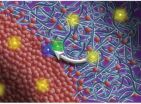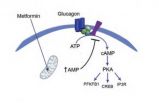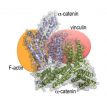(Press-News.org) Why are efficient and affordable solar cells so highly coveted? Volume. The amount of solar energy lighting up Earth's land mass every year is nearly 3,000 times the total amount of annual human energy use. But to compete with energy from fossil fuels, photovoltaic devices must convert sunlight to electricity with a certain measure of efficiency. For polymer-based organic photovoltaic cells, which are far less expensive to manufacture than silicon-based solar cells, scientists have long believed that the key to high efficiencies rests in the purity of the polymer/organic cell's two domains – acceptor and donor. Now, however, an alternate and possibly easier route forward has been shown.
Working at Berkeley Lab's Advanced Light Source (ALS), a premier source of X-ray and ultraviolet light beams for research, an international team of scientists found that for highly efficient polymer/organic photovoltaic cells, size matters.
"We've shown that impure domains if made sufficiently small can also lead to improved performances in polymer-based organic photovoltaic cells," says Harald Ade, a physicist at North Carolina State University, who led this research. "There seems to be a happy medium, a sweet-spot of sorts, between purity and domain size that should be much easier to achieve than ultra-high purity."
Ade, a longtime user of the ALS, is the corresponding author of a paper describing this work in Advanced Energy Materials titled "Absolute Measurement of Domain Composition and Nanoscale Size Distribution Explains Performance in PTB7:PC71 BM Solar Cells." Co-authors are Brian Collins, Zhe Li, John Tumbleston, Eliot Gann and Christopher McNeill.
Solar cell conversion efficiency in polymer/organic photovoltaic cells hinges on excitons – electron/hole pairs energized by sunlight – getting to the interfaces of the donor and acceptor domains quickly so as to minimize energy lost as heat. Conventional wisdom held that the greater the purity of the domains, the fewer the impedances and the faster the exciton journey.
Ade and his co-authors became the first to simultaneously measure the domain size, composition and crystallinity of an organic solar cell. This feat was made possible by ALS beamlines 11.0.1.2, a Resonant Soft X-ray Scattering (R-SoXS) facility; 7.3.3, a Small- and Wide-Angle X-Ray Scattering (SAXS/WAXS/) end-station; and 5.3.2, an end-station for Scanning Transmission X-Ray Microscopy (STXM).
Says Collins, the first author on the Advanced Energy Materials paper, "The combination of these three ALS beamlines enabled us to obtain comprehensive pictures of polymer-based organic photovoltaic film morphology from the nano- to the meso-scales. Until now, this information has been unattainable."
The international team used the trifecta of ALS beams to study the polymer/fullerence blend PTB7:PC71BM in thin films made from chlorobenzene solution with and without the addition (three-percent by volume) of the solvent diiodooctane. The films were composed of droplet-like dispersions in which the dominant acceptor domain size without the additive was about 177 nanometers. The addition of the solvent shrank the acceptor domain size down to about 34 nanometers while preserving the film's composition and crystallinity. This resulted in an efficiency gain of 42-percent.
"In showing for the first time just how pure and how large the acceptor domains in organic solar devices actually are, as well as what the interface with the donor domain looks like, we've demonstrated that the impact of solvents and additives on device performance can be dramatic and can be systematically studied," Ade says. "In the future, our technique should help advance the rational design of polymer-based organic photovoltaic films."
This research was primarily supported by the DOE Office of Science, which also supports the ALS.
INFORMATION:
Lawrence Berkeley National Laboratory addresses the world's most urgent scientific challenges by advancing sustainable energy, protecting human health, creating new materials, and revealing the origin and fate of the universe. Founded in 1931, Berkeley Lab's scientific expertise has been recognized with 13 Nobel prizes. The University of California manages Berkeley Lab for the U.S. Department of Energy's Office of Science. For more, visit www.lbl.gov.
DOE's Office of Science is the single largest supporter of basic research in the physical sciences in the United States, and is working to address some of the most pressing challenges of our time. For more information, please visit the Office of Science website at science.energy.gov/.
New path to more efficient organic solar cells uncovered at Berkeley Lab's advanced light source
2013-01-07
ELSE PRESS RELEASES FROM THIS DATE:
How the kilogram has put on weight
2013-01-07
Post-Christmas and most of us are feeling the over-indulgence. But take heart - experts at Newcastle University, UK, have shown even the kilogram itself has put on weight. Using a state-of-the-art Theta-probe XPS machine – the only one of its kind in the world – the team have shown the original kilogram is likely to be tens of micrograms heavier than it was when the first standard was set in 1875.
And they say a suntan could be the key to helping it lose weight.
The original kilogram – known as the International Prototype Kilogram or the IPK – is the standard against ...
New antimatter method to provide 'a major experimental advantage'
2013-01-07
Researchers have proposed a method for cooling trapped antihydrogen which they believe could provide 'a major experimental advantage' and help to map the mysterious properties of antimatter that have to date remained elusive.
The new method, developed by a group of researchers from the USA and Canada, could potentially cool trapped antihydrogen atoms to temperatures 25 times colder than already achieved, making them much more stable and a lot easier to experiment on.
The suggested method, which has been published today, 7 January 2013, in IOP Publishing's Journal of ...
Most-used diabetes drug works in different way than previously thought
2013-01-07
PHILADELPHIA - A team, led by senior author Morris J. Birnbaum, MD, PhD, the Willard and Rhoda Ware Professor of Medicine, with the Institute for Diabetes, Obesity, and Metabolism, Perelman School of Medicine, University of Pennsylvania, found that the diabetes drug metformin works in a different way than previously understood. Their research in mice found that metformin suppresses the liver hormone glucagon's ability to generate an important signaling molecule, pointing to new drug targets. The findings were published online this week in Nature.
For fifty years, one ...
Genetic mystery of Behcet's disease unfolds along the ancient Silk Road
2013-01-07
Researchers have identified four new regions on the human genome associated with Behcet's disease, a painful and potentially dangerous condition found predominantly in people with ancestors along the Silk Road. For nearly 2,000 years, traders used this 4,000-mile network linking the Far East with Europe to exchange goods, culture and, in the case of the Silk Road disease, genes. National Institutes of Health researchers and their Turkish and Japanese collaborators published their findings in the Jan. 6, 2013, advance online issue of Nature Genetics.
Named for the Turkish ...
From the Amazon rainforest to human body cells: Quantifying stability
2013-01-07
As they typically result from severe external perturbations, it is of vital interest how stable the most desirable state is. Surprisingly, this basic question has so far received little attention. Now scientists of the Potsdam Institute for Climate Impact Research (PIK), in a paper published in Nature Physics, propose a new concept for quantifying stability.
"Up to now, science was able to say if a complex system is stable or not, but it wasn't able to properly say how stable it is," says Peter J. Menck, lead author of the paper. The proposed concept is the first to fill ...
A new approach to assessing future sea level rise from ice sheets
2013-01-07
The study, published today in Nature Climate Change, is the first of its kind on ice sheet melting to use structured expert elicitation (EE) together with an approach which mathematically pools experts' opinions. EE is already used in a number of other scientific fields such as forecasting volcanic eruptions.
The ice sheets covering Antarctica and Greenland contain about 99.5 per cent of the Earth's glacier ice which would raise global sea level by some 63m if it were to melt completely. The ice sheets are the largest potential source of future sea level rise – and ...
The pain puzzle: Uncovering how morphine increases pain in some people
2013-01-07
Quebec City & Toronto, January 6, 2013—For individuals with agonizing pain, it is a cruel blow when the gold-standard medication actually causes more pain. Adults and children whose pain gets worse when treated with morphine may be closer to a solution, based on research published in the January 6 on-line edition of Nature Neuroscience.
"Our research identifies a molecular pathway by which morphine can increase pain, and suggests potential new ways to make morphine effective for more patients," says senior author Dr. Yves De Koninck, Professor at Université Laval in ...
New study defines the long-sought structure of a protein necessary for cell-cell interaction
2013-01-07
JUPITER, FL, January 6, 2012 – Scientists know that cells in all higher organisms cells need to bind to each other for the development, architecture, maintenance and function of tissues. Mysteries have remained, however, about exactly how cells manage this feat.
Scientists from the Florida campus of The Scripps Research Institute (TSRI) have now solved part of this puzzle by defining the structure of a protein known as α-catenin, which is essential to this process.
The work was published online ahead of print on January 6, 2012, by the journal Nature Structural ...
Joslin researchers identify important factor in fat storage and energy metabolism
2013-01-07
BOSTON – January 8, 2013 -- As part of their ongoing research on the physiologic factors that contribute to the development of obesity, Joslin Diabetes Center scientists have identified a cell cycle transcriptional co-regulator – TRIP-Br2 – that plays a major role in energy metabolism and fat storage. This finding has the potential to lead to new treatments for obesity. The study is being published today ahead of print by Nature Medicine.
Transcriptional co-regulators manage the expression of DNA, either by activating or suppressing the expression of genes. TRIP-Br2 ...
Astrophysicists find wide binary stars wreak havoc in planetary systems
2013-01-07
VIDEO:
This movie shows two simulations of planetary system disruption by galactic disturbances to wide binary stars. On the left is a zoomed-out view showing the orbit of a hypothetical 0.1...
Click here for more information.
TORONTO, ON – An international team of astrophysicists has shown that planetary systems with very distant binary stars are particularly susceptible to violent disruptions, more so than if they had stellar companions with tighter orbits around them.
Unlike ...



